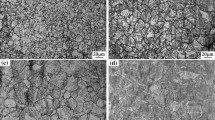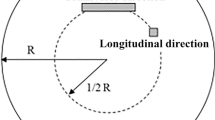Abstract
Mooring chain steel has been widely used for stabilizing offshore platforms and suffers from stress corrosion cracking. Herein, the microstructure difference, its relation to strength and susceptibility of stress corrosion cracking after tempered at different temperatures have been studied. Result shows increasing tempering temperature increases the proportion of low value CSL boundaries, decreases the local misorientation angle and promotes the precipitation of carbides. These factors induced the decrease of SCC susceptibility at higher tempering temperature. The resistance to SCC at 640 °C tempering temperature is about 20% higher than that of 580 °C at − 1000 mVSCE. The main strengthening mechanism of the ultra-high-strength steel is ultra-fine grain strengthening mechanism, precipitation strengthening mechanism, and dislocation strengthening mechanism. Increasing tempering temperature from 580 to 640 °C decreases the yield strength by 85 MPa, which is mainly attributed to larger carbides size.













Similar content being viewed by others
References
A. Belaniand and S. Orr, A Systematic Approach to Hostile Environments, J. Pet. Technol., 2008, 60, p 34.
J. Speer, D.K. Matlock, B.C. De Cooman and J.G. Schroth, Carbon Partitioning into Austenite after Martensite Transformation, Acta Mater., 2003, 51, p 2611.
D.K. Matlock, V.E. Bräutigam and J.G. Speer, Application of the Quenching and Partitioning (Q&P) Process to a Medium-Carbon, High-Si Microalloyed Bar Steel, Mater. Sci. Forum., 2003, 426–432, p 1089.
P. Xu, J. Yin and S. Zhang, Tensile Deformation Behavior of Hydrogen Charged Ultrahigh Stength Steel Sudied by In Situ Neutron Diffraction, Acta. Metall. Sin., 2015, 051, p 1297.
S. Das, A. Ghosh, S. Chatterjee and P.R. Rao, The Effect of Cooling Rate on Structure and Properties of a HSLA Forging, Scripta. Mater., 2003, 48, p 51.
Z. Tangand and W. Stumpf, The Effect of Microstructure and Processing Variables on the Yield to Ultimate Tensile Strength Ratio in a Nb-Ti and a Nb-Ti-Mo Line Pipe Steel, Mater. Sci. Eng, 2008, 490, p 391.
A. Garikoitz, A. Alberto, A. Fernández-Calvo and A. Javier, Hydrogen Embrittlement Susceptibility of R4 and R5 High-Strength Mooring Steels in Cold and Warm Seawater, Metals-Basel, 2018, 8, p 700.
J.H. Bulloch, Some Effects of Yield Strength on the Stress Corrosion Cracking Behaviour of Low Alloy Steels in Aqueous Environments at Ambient Temperatures, Eng. Fail. Anal., 2004, 11, p 843.
S.J. Yoon, H.J. Lee, K.B. Yoon, Y.W. Ma and U.B. Baek, Hydrogen Damage in 34CrMo4 Pressure Vessel Steel with High Tensile Strength, J. Mech. Sci. Technol., 2018, 32, p 637.
L. Song, Z. Liu, J. Hu, X. Li and Y. Pan, Stress Corrosion Cracking of 2205 Duplex Stainless Steel with Simulated Welding Microstructures in Simulated Sea Environment at Different Depths, J. Mater. Eng. Perform., 2020, 29, p 5476.
L. Song, Z. Liu, X. Li and C. Du, Stress Corrosion Cracking of Simulated Weld Heat-Affected Zone on X100 Pipeline Steel in Carbonate/Bicarbonate Solution, J. Mater. Eng. Perform., 2020, 29, p 2547.
Y.Z. Jia, J.Q. Wang, E.H. Han and W. Ke, Stress Corrosion Cracking of X80 Pipeline Steel in Near-Neutral pH Environment Under Constant Load Tests with and Without Preload, J. Mater. Sci. Technol., 2011, 27, p 1039.
M.C. Zhao, Y.Y. Shan, R.X. Fu, Y. Ke and H.L. Yu, Investigation on the H2S-Resistant Behaviors of Acicular Ferrite and Ultrafine Ferrite, Mater Lett, 2002, 57, p 141.
R.A. Carneiro, R.C. Ratnapuli and V.D.F.C. Lins, The Influence of Chemical Composition and Microstructure of API Linepipe Steels on Hydrogen Induced Cracking and Sulfide Stress Corrosion Cracking, Mater. Sci. Eng., A, 2003, 357, p 104.
J. Lv, Effect of Grain Size on Mechanical Property and Corrosion Resistance of the Ni-based Alloy 690, J. Mater. Sci. Technol., 2018, 34, p 1685.
S. Frappart, X. Feaugas, J. Creus, F. Thebault, L. Delattre and H. Marchebois, Study of the Hydrogen Diffusion and Segregation into Fe-C-Mo Martensitic HSLA Steel using Electrochemical Permeation Test, J Phys Chem Solids, 2010, 71, p 1467.
J.P. Hirth, Effects of Hydrogen on the Properties of Iron And Steel, Metall. Trans. A, 1980, 11, p 861.
M. Dhondt, I. Aubert, N. Saintier and J.M. Olive, Effects of Microstructure and Local Mechanical Fields on Intergranular Stress Corrosion Cracking of a Friction Stir Welded Aluminum–Copper–Lithium 2050 Nugget, Corros. Sci., 2014, 86, p 123.
M.A. Arafinand, J.A. Szpunar, A New Understanding of Intergranular Stress Corrosion Cracking Resistance of Pipeline Steel Through Grain Boundary Character and Crystallographic Texture Studies. Corros. Sci., 2009, 51 119
J. Hou, Q.J. Peng, T. Shoji, J.Q. Wang, E.H. Han and W. Ke, Effects of Cold Working Path on Strain Concentration, Grain Boundary Microstructure and Stress Corrosion Cracking in Alloy 600, Corros. Sci., 2011, 53, p 2956.
B. Pawlowski, A. Mazur and S. Gorczyca, The Effect of the Tempering Processes on the Susceptibility to Stress Corrosion Cracking of High Strength Steel, Corros. Sci., 2010, 22, p 685.
G.M. Pressouyre, A Classification of Hydrogen Traps in Steel, Metall. Trans. A, 1979, 10, p 1571.
Haq JA, Muzaka K, Dunne PD, Calka A, Pereloma, and VE, 2013 Effect of Microstructure and Composition on Hydrogen Permeation in X70 Pipeline Steels. Int J Hydrogen Energ 2544.
J. Takahashi, K. Kawakami, Y. Kobayashi and T. Tarui, The First Direct Observation of Hydrogen Trapping Sites in TiC Precipitation-Hardening Steel through Atom Probe Tomography, Scripta Mater, 2010, 63, p 261.
Y.S.. Chen, H. lu, J. Liang, A.. Rosenthal, H. Liu, G. Sneddon, I. McCarroll, Z.Z. Zhao, W. Li, A.. Guo, and J. Cairney, Observation of hydrogen trapping at dislocations, grain boundaries, and precipitates. Science, 2020, pp 367–171.
D.-H. Ping, Understanding Solid–Solid (fcc → ω + bcc) Transition at Atomic Scale, Acta Metallurgica Sinica (English Letters), 2015, 28, p 663.
J. Yin, ω-Fe Phase in Carbon Steels and its Recent Progress, Heat. Treat., 2019, 34, p 27.
Jae Hoon, Jang and, In Gee, Kim and, KDHH and Bhadeshia, ε-Carbide in Alloy Steels: First-Principles Assessment. Scripta Mater., 2010, 63 121.
H.Y. Liand and X.J. Jin, Determination of Dislocation Density in Nanostructured Bainitic steels, J. Shanghai Jiaotong Univ. (Chin. Ed.), 2010, 44, p 613.
W. Song, J. von Appen, P. Choi, R. Dronskowski, D. Raabe and W. Bleck, Atomic-Scale Investigation of ε and θ Precipitates in Bainite in 100Cr6 Bearing Steel by Atom Probe Tomography and ab Initio Calculations, Acta Mater., 2013, 61, p 7582.
M. Liu, C. Wang, Y. Dai, X. Li and G. Cao, Effect of Quenching and Tempering Process on Sulfide Stress Cracking Susceptibility in API-5CT-C110 Casing Steel, Mater. Sci. Eng., A, 2017, 688, p 378.
S. Junaidi, N. Koichi, T. Toshihiro and T. Setsuo, Effect of Solute Copper on Yield Strength in Dislocation-Strengthened Steels, Tetsu- to- Hagane, 2005, 91, p 340.
M. Charleux, W.J. Poole, M. Militzer and A. Deschamps, Precipitation Behavior and its Effect on Strengthening of an HSLA-Nb/Ti Steel, Metall. and Mater. Trans. A., 2001, 32, p 1635.
H. Halfa, Recent Trends in Producing Ultrafine Grained Steels, J. Miner Mater. Char. Eng., 2014, 02, p 428.
T. Narutaniand, J. Takamura, Grain-Size Strengthening in Terms of Dislocation Density Measured by Resistivity. Acta Metallurgica Et Materialia, 1991, 39, p 2037.
E.O. Hall, The Deformation and Ageing of Mild Steel: Ii Characteristics of the Lüders Deformation, Proc. Phys. Soc. B, 1951, 64, p 742.
N. Petch, The Cleavage Strength of Polycrystals, J. Iron Steel Inst. Lond., 1953, 173, p 25.
N.J. Petch, The Influence of Grain Boundary Carbide and Grain Size on the Cleavage Strength and Impact Transition Temperature of Steel, Acta Metall., 1986, 34, p 1387.
J.W. Fan, Q.Y. Liu, H.R. Hou, H.J. Chen and H. Dong, Strength of Ultra-Fine Grained Ferrite Steel, Heat Treat. Met., 2003, 28, p 5.
T. Gladman, Precipitation Hardening in Metals, Mater Sci Tech-Lond, 1999, 15, p 30.
M.E. Kassner and K. Kyle, Taylor Hardening in Five-Power-Law Creep of Metals and Class M Alloys, Acta Mater., 2004, 52, p 1.
Y. Li, Z. Liu, E. Fan, Z. Cui and J. Zhao, The Effect of Crack Tip Environment on Crack Growth Behaviour of a Low Alloy Steel at Cathodic Potentials in Artificial Seawater, J. Mater. Sci. Technol., 2020, 54, p 119.
J. Li, X. Gao, L. Du and Z. Liu, Relationship Between Microstructure and Hydrogen Induced Cracking Behavior in a Low Alloy Pipeline Steel, J. Mater. Sci. Technol., 2017, 33, p 1504.
V.S.. Raja. Stress Corrosion Cracking - Theory and Practice, Woodhead Publishing Limited, 2011, p 792
M.A. Arafin and J.A. Szpunar, A New Understanding of Intergranular Stress Corrosion Cracking Resistance of Pipeline Steel through Grain Boundary Character and Crystallographic Texture Studies, Corros. Sci., 2009, 51, p 119.
L.C. Lim and T. Watanabe, Fracture Toughness and Brittle-Ductile Transition Controlled by Grain Boundary Character Distribution (GBCD) in Polycrystals, Acta Metall. Mater., 1990, 38, p 2507.
D.C. Crawfordand and G.S. Was, The Role of Grain Boundary Misorientation in Intergranular Cracking of Ni-16Cr-9Fe in 360 °C Argon and High-Purity Water, Metall. Trans. A, 1992, 23, p 1195.
D. Ping, J. Yin, W. Liu, Y. Su, L. Rong and X. Zhao, The ω Phase in a Low Alloy Martenstitic Steel, Acta Metall. Sin., 2013, 49, p 769.
A. Nagao, M. Dadfarnia, B.P. Somerday, P. Sofronis and R.O. Ritchie, Hydrogen-Enhanced-Plasticity Mediated Decohesion for Hydrogen-Induced Intergranular and “Quasi-Cleavage” Fracture of Lath Martensitic Steels, J. Mech. Phys. Solids, 2018, 112, p 403.
H. Tian, J. Xin, Y. Li, X. Wang and Z. Cui, Combined Effect of Cathodic Potential and Sulfur Species on Calcareous Deposition, Hydrogen Permeation, and Hydrogen Embrittlement of a Low Carbon Bainite Steel in Artificial Seawater, Corros. Sci., 2019, 158, p 108089.
Acknowledgments
This work was supported by the National Natural Science Foundation of China (No. 51871024). The authors would thank Prof. Yin Jiang (Jiangsu Asian Star Anchor Chain Co., Ltd.) for providing critical advice of this work.
Author information
Authors and Affiliations
Corresponding authors
Additional information
Publisher's Note
Springer Nature remains neutral with regard to jurisdictional claims in published maps and institutional affiliations.
Rights and permissions
About this article
Cite this article
Liu, M., Guo, H., Liu, Z. et al. Effect of Tempering Temperature on the Microstructure and Stress Corrosion Cracing Susceptibility of Ultra-High-Strength Mooring Steel. J. of Materi Eng and Perform 30, 4217–4229 (2021). https://doi.org/10.1007/s11665-021-05764-7
Received:
Accepted:
Published:
Issue Date:
DOI: https://doi.org/10.1007/s11665-021-05764-7




